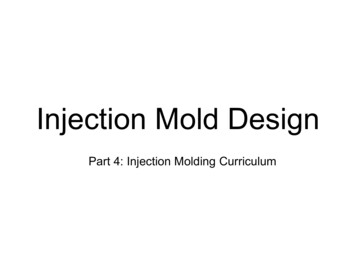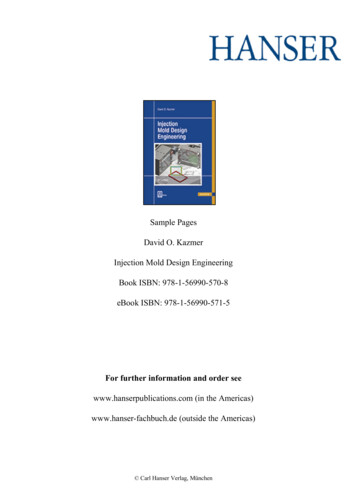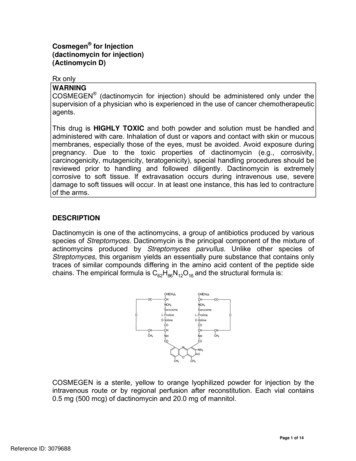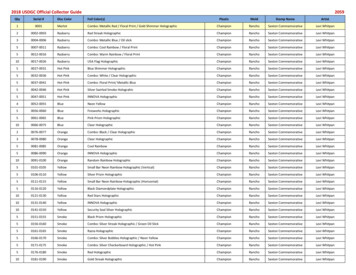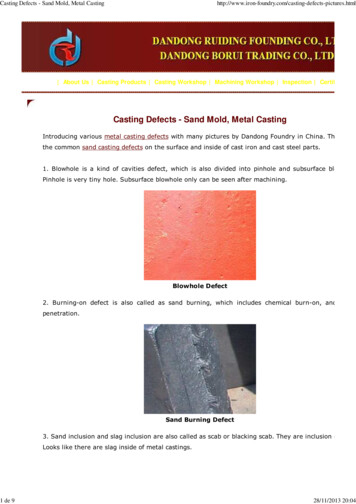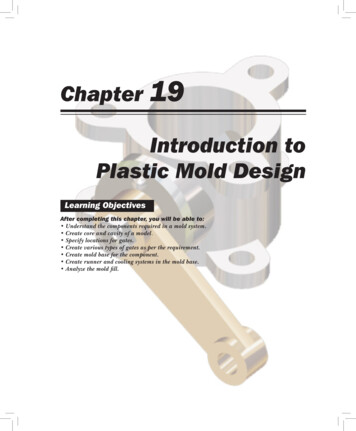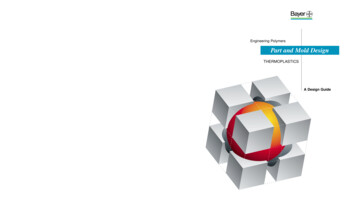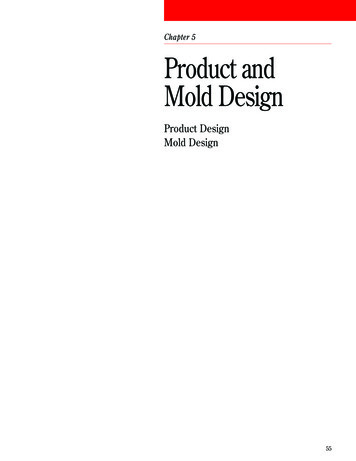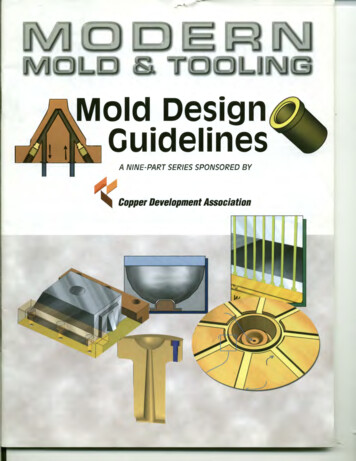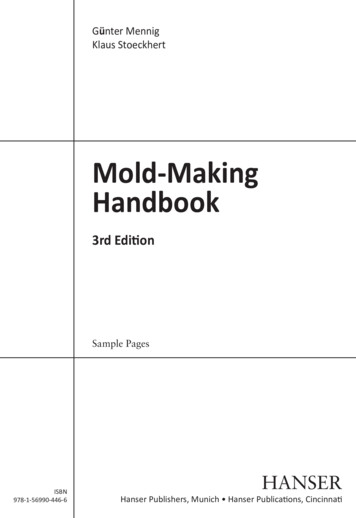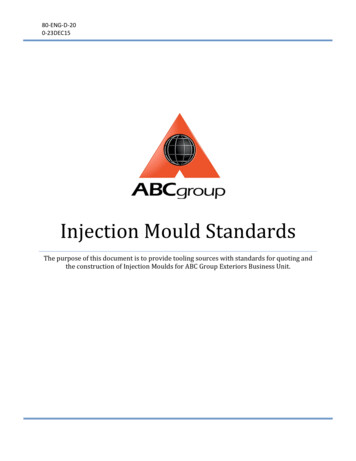
Transcription
80‐ENG‐D‐200‐23DEC15Injection Mould StandardsThe purpose of this document is to provide tooling sources with standards for quoting andthe construction of Injection Moulds for ABC Group Exteriors Business Unit.
INJECTION MOULD STANDARDS All contents are protected by copyright. The copyright for any material (in any form) createdby ABC Group Inc. is reserved.Any duplication or use of content other than for the purposes prescribed in this Manual or in anyelectronic or printed publications is not permitted without the written consent of ABC Group Inc.This electronic edition of the Manual supersedes all other forms of the Manual.Page 1 of 2080‐ENG‐D‐200‐23DEC15
INJECTION MOULD STANDARDSTable of ContentsAbstract. 3Section 1: Introduction . 4Section 2: Mould Design . 4Section 3: Mould Delivery & Progress Reports . 7Section 4: Mould Sampling Requirements . 7Section 5: Mould Certification & Build Tolerance . 7Section 6: Mould Supplier Maintain Cost & Quality . 8Section 7: Mould Identification. 8Section 8: General Mould Construction . 9Section 9: Mould Surface Finish . 10Section 10: General Mould Steels & Components . 10Section 11: Runners & Gating . 11Section 12: Hot Runner Manifolds / Hot Sprue Bushing . 11Section 13: Inserts . 12Section 14: Parting Line & Vents. 12Section 15: Mould Locks . 13Section 16: Waterlines . 13Section 17: Leader Pins . 14Section 18: Ejection . 15Section 19: Return Pins & Support Pillars . 15Section 20: Die Springs & Clamp Slots . 16Section 21: Mould Lubrications . 16Section 22: Slides . 16Section 23: Lifters . 17Section 24: Hydraulic Cylinders . 18Section 25: Welding / Heat Treating . 19Section 26: SPT . 19Section 27: Shipping / Transportation . 19Page 2 of 2080‐ENG‐D‐200‐23DEC15
INJECTION MOULD STANDARDSAbstract This Injection Mould Standard has been developed by ABC Group Exterior Business Unit todocument standard practices developed using lessons learned and best practices in the design& builds of Injection Moulds. The design of a good Injection Mould permits repeatable moulding of parts free of sink, readthrough, deformation and other poor characteristics. Using this standard, ABC Group is ableto produce quality parts that conform to customer expectations and continue to receiverecognition as one of the most reputable suppliers in North America.Page 3 of 2080‐ENG‐D‐200‐23DEC15
INJECTION MOULD STANDARDSSection 1: Introduction1. The purpose of this document is to provide tooling sources with standards for quoting andconstruction of injection moulds for ABC Group.2. ABC Group values supplier’s opinion and encourages all tool sources to submit theirrecommendations to improve the quality and effectiveness for moulds.3. The intent of this document is not to include all possible requirements and thereforeconsultation for specific customer standards or requirements with each new project isnecessary.4. The information disclosed in this Mould Standard is considered privileged and confidentialmaterial. Any disclosure, copying or distribution of these documents without ABC Group’sauthorization is prohibited. If any of the following pages are missing or unclear pleasecontact ABC Group’s Engineering Department.Section 2: Mould Design1. A series of design reviews are to be initiated in a timely manner by the tool source.Participants should include personnel from the facility that will be involved in running thetools.a) Kick Off Meeting: Will be held in order to discuss any particular tool requirementsand to establish possible gate locations and gate type in order to proceed with mouldflow.b) Preliminary Design Review: Establish general steel sizes and tool actions; Pressspecifications will be provided by ABC Engineering.c) Cooling Review: Cooling review of all mould components, core, cavity and anyactions that would require cooling.d) Intermediate Design Review: Review of parting lines, actions, locks and seal offs.e) Final Design Review: Capturing all input gathered from prior reviews.Note: “OK –TO – TOOL” approval must be signed by ABC group Engineering and in somecases, ABC’s customer. “OK –TO – TOOL” may be required during design stages depending onjob specific requirements.Page 4 of 2080‐ENG‐D‐200‐23DEC15
INJECTION MOULD STANDARDS2. Mold Flow Analysisi. All injection mold tools manufactured for ABC Group must have aMoldflow analysis study performed to simulate the flow of moltenpolymer inside the runner and mold systemii. The purpose of Moldflow analysis is to help optimizing plastic part andinjection mold designs, reduce potential part defects, and optimize themolding process settingiii. Moldflow analysis simulates the injection molded polymer meltthroughout the mold with data collected for interpretationiv. The Moldflow program covers three levels: Bronze, Silver, and Gold. Theselected level for analysis should be identified by Moldflow requester asper customer certification requirementv. A series of meetings are to be initiated in a timely manner by theMoldflow Analyst to determine the best gating and runner systems andcavitation strategies. Meeting participants should include ToolingSpecialist and Project Engineer/Program Manager and the personnel fromthe facility involved in running the tools, if necessaryvi. The Moldflow analysis study should be performed preferably by CAETeam within ABC Group and outsourced if necessary. The outsourcedanalysis must be approved by ABC Group prior to any steel order and cutvii. Prior to Moldflow analysis the position of part inside the mold withrespect to nozzle location must be knownviii. Material grade with required CRIMS/shrinkage data known as UDB fileshould be provided by the Moldflow requesterix. In case the UDB file is not available efforts should be done to prepare thedata through a recognized lab or resin should be switched to a grade withavailable UDB filex. The Moldflow analysis should include fill, pack, ideal and actual cooling,warp analysis, and optimization processxi. Filling: to help predict the flow of melted plastic and fill mold cavitiesuniformly; avoid short shots; and eliminate, minimize, or reposition weldlines and air trapsxii. Packing: optimize packing profiles and visualize magnitude anddistribution of volumetric shrinkage to help minimize plastic part warpageand reduce defects such as sink marksxiii. Injection pressure should not exceed 80% of machine rating withoutwritten authorization from ABC Groupxiv. Potential defects determined by Moldflow analysis should be addressed inthe result presentation with recommendation on how to avoid those defectsxv. Moldflow analysis includes the following steps:xvi. Import the CAD data into the software: The acceptable formats are IGES,STEP, and Parasolidxvii. Mesh the model: In order to analyze fluid flows, flow domains are splitinto smaller subdomains (made up of geometric primitives like hexahedraPage 5 of 2080‐ENG‐D‐200‐23DEC15
INJECTION MOULD .xxvii.xxviii.and tetrahedral in 3D and quadrilaterals and triangles in 2D) that arecollectively known as meshing.Examine the mesh deficiencies e.g. overlaps, discontinuity, anddimensional inconsistenciesStart the analysisPerform process setting and part geometry upgrades and re-analyze asmany iterations as required to improve processing or molding conditionsDeliverables:Preliminary report: Gate locations, runner system, part modificationproposals, knit line locations, cooling design modifications andGMW16355 outputs will be submitted as needed throughout the projectFinal report: A comprehensive final report will be issued at the end of theproject which will include the following:Summary of the objectives achievedPart design, mold design, and processing setup/recommendationsMold informationDetailed results for Fill, Pack, Cool, and WarpageWhere outside vendors are engaged a copy of the final Analysisinput/output files is to be forwarded to ABC Tech Centre CAE team fordatabankingxxix. Sourcing:xxx. All quotes and purchases orders to be released through ABC Group TechCentre CAE Service team. CAE Service team will assist PM/PE/ME withtechnical aspects of the process and achieving timing requirements.xxxi. A DCS is to be issued into the MyABC Parts database application tosupport scheduling and databanking3. It is the responsibility of the tool source to update mould design when incorporatingengineering changes regardless of whether the mould is under construction or completed.4. A complete bill of material is to be provided specifying original manufacturer, part numberand origin of purchase.5. Original hot runner supplier designs (2D&3D) & BOMs are to be provided to ABC.6. Approval of mould design from ABC does not relieve tool vendor of responsibility ofdelivering a tool that produces a dimensionally correct part within the quoted cycle time.7. It is expected that during the tool design stages, the tool maker will identify and notify ABCif there are any part features (rib to wall ratios, minimal draft, etc.) that could affect theperformance of the tool or produce an unacceptable part.8. All CAD data, feasibility reports, mould flows and tooling aids are to be consideredintellectual property of ABC and shall made available to ABC at any time. Upon completionPage 6 of 2080‐ENG‐D‐200‐23DEC15
INJECTION MOULD STANDARDSof mould, tool source is to provide ABC all of the above mentioned items. Mould designs areto be provided in their native software format as well as a copy in .STP format.9. All moulded parts are to have identification:a) Part number.b) Material type.c) Date wheel/grid.d) Any other identification required will be provided by ABC Engineering.Section 3: Mould Delivery & Progress Reports1. Established delivery dates must be held. This is for both new moulds and engineeringchanges on existing moulds. Failure to meet this date may result in down rating. Please note,the effect of engineering changes that occur during a new build will be factored into the finaldue date.2. A tool timeline is to be provided at kick off. Tool progress reports maybe requested at anytime during the build. Frequency of progress reports will be job specific.Section 4: Mould Sampling Requirements1. Sampling requirements are a minimum of 3 trials at an agreed upon trial facility. Quantity ofsamples is 150 pieces per trial but requirements will be job specific and will be clarified inoriginal RFQ.2. It is the tool shop’s responsibility to sample the mould as many times as necessary to proveout the mechanical and dimensional integrity of the mould, including any unacceptable flash,mismatch of parting lines or surface finishes.3. One day plant support (toolmaker at ABC facility) at an agreed upon time is to be providedby tool source for each tool.Section 5: Mould Certification & Build Tolerance1. Prior to first shot, the mould is to be CMM checke
Part design, mold design, and processing setup/recommendations xxvi. Mold information xxvii. Detailed results for Fill, Pack, Cool, and Warpage xxviii. Where outside vendors are engaged a copy of the final Analysis input/output files is to be forwarded to ABC Tech Centre CAE team for databanking xxix. Sourcing: xxx. All quotes and purchases orders to be released through ABC Group Tech Centre .
